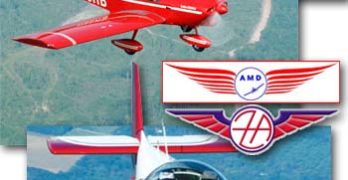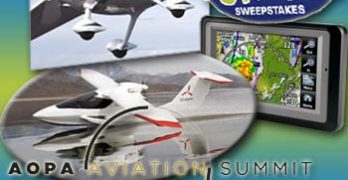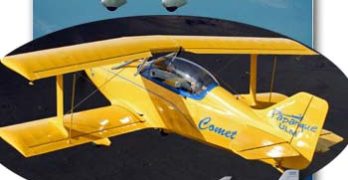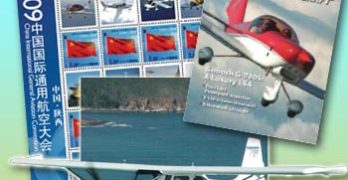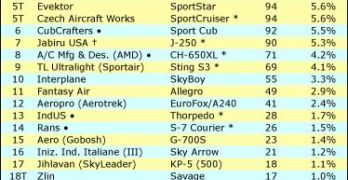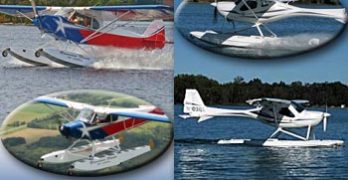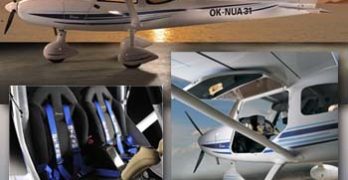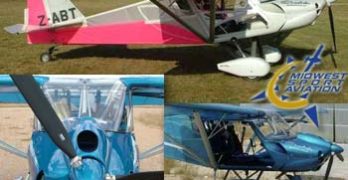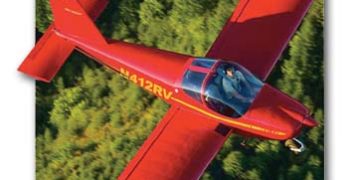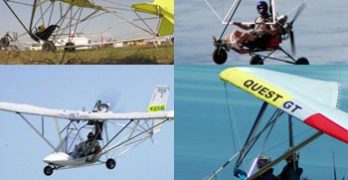Bad as in-flight break-up accidents are, many opinions often blur the big picture. Last spring NTSB recommended FAA “ground the fleet,” so to say. FAA chose further study. When additional CH-601s became involved, media and organizations jumped on the bandwagon. Let’s review. *** The focus is on the CH-601XL, of which about 1,500 kits have been sold since its introduction in 1984. Approximately half are complete and flying, said Zenith boss, Sebastien Heintz. *** Of the airplanes that broke up two were fully-built SLSA. One was built by Czech Aircraft Works; the other by AMD. The rest are owner-built kits… essentially one-off airplanes. Comparing one to a factory-built airplane is apples and oranges. *** Some allege Zenith and AMD have ignored the problem, but lots of detailed info on Zenith’s website suggests otherwise. Sebastien buttressed this saying, “We believe our effort is an example of an industry doing the right thing.
AOPA Summit 2009 Broadens Outreach of LSA
In its first year as the AOPA “Summit” (versus “Expo”), the 70-year-old, 415,000-member organization made lots of changes large and small. Among the most notable under capable new president Craig Fuller was much greater attention to LSA. Here’s the fast-read update… *** AOPA announced their 2010 Sweepstakes airplane is a Remos GX; the company had multiple displays and aircraft. Cessna brought a Skycatcher for selected reporters to fly. Craig Fuller had Icon A5 developer Kirk Hawkins on the center-hall stage. EAA’s Earl Lawrence led a LSA panel of FAA and industry experts (including yours truly). LAMA operated an LSA Mall area and had fruitful discussions with AOPA to advance goals of the LSA industry. SeaMax USA showed off their simulator seaplane running on MS Flight Sim. Tecnam North America, with several aircraft on display, announced new service centers for the popular Italian line of aircraft they now represent.
Triple Play: Fk Lightplanes Is High, Low, and Bipe
Light-Sport Aircraft are nothing if not diverse. We have all manner of aircraft on our SLSA List of 104 approved models. Germany’s FK Lightplanes illustrates diversity through their trio of models: high wing Fk9 series; biplane Fk-12; and low wing Fk14. *** In May 2009, the newest iteration of the Fk9 series was flown by designer Peter Funk. The Fk9 ELA (a reference to European Light Aircraft, a new class EASA is planning) is a stretched, roomier model of the popular series. The changes should play well in the American market. *** Peter Funk commented, “It seemed that [Fk9 ELA’s new] winglets are improving control efficiency and low speed characteristics.” In addition, the newest model boasts a larger cabin space, a larger panel with room for big screens, more baggage area, electric flaps, and optional longer-range fuel tanks. The versatile Fk9 ELA is also available on straight or amphibious floats or in taildragger gear.
Changing Times…and Light-Sport Aircraft’s Future
Word of a few interesting developments arrived in my inbox, bringing with them new questions. *** Point One — EAA announced it will cease publishing Sport Pilot and Light-Sport Aircraft magazine. LSA content will be merged into their flagship Sport Aviation title, bolstered by a new eNewsletter called “Light Plane World” that will focus on LSA and ultralights. *** Point Two — An Australian company, Foxcon, alerted me about their SLSA, the Terrier 200. It’s not presently for sale in the U.S. But they say it has government approval just like the other 104 aircraft on our SLSA List. To assure our list remains up-to-date, a key feature of the SLSA List, do we add the Terrier 200? Is ByDanJohnson.com is an American product for Americans or a world citizen? *** Point Three — China is hosting an international GA conference and is featuring Cirrus, Diamond, and Cessna, and, not least, Flight Design in promoting CIGAC.
LSA Market Shares Are Stable through August 2009
As the challenging year for aircraft sales grinds on, Light-Sport Aircraft continue to hold their own. In tough times, when cash is tight, small enterprises may fare better than large companies. Their low expense structures, modestly compensated managers and employees, and lean manufacturing — as allowed by industry-standards certification — become strengths. *** But we see another quality. The half-million-plus general aviation pilots are more accepting of LSA today than three years ago. Organizations like AOPA are more fully embracing LSA, because their members are calling to ask questions. (Watch for a surprise LSA announcement at AOPA’s Aviation Summit in about a month!) GA pilots make up most buyers of LSA and those aviators now recognize the brands and have begun to acquire faith in companies certifying themselves (though many are still reserving judgement). *** Through August, a full month after AirVenture, the LSA fleet has grown to just under 1,700 fully-built aircraft not including ELSA kits or alternative aircraft like trikes and powered parachutes, nor any converted ultralights.
Pair of Floatplanes Announced: Legend and Remos
We’ve arrived at the end of the main float-flying season, but two of our largest Light-Sport Aircraft manufacturers just announced floatplane models. Welcome to the American Legend FloatCub and the Remos GX on floats. Each company contracted with float experts (a big difference from SeaMax or SeaRey). *** The most successful American LSA producer, American Legend won approval on October 2 for their Amphibious Legend FloatCub after declaring they met ASTM standards. FloatCub was put on sale for $159,000 and the first customer aircraft is being assembled. Legend went to long-established float company, Baumann Floats of New Richmond, Wisconsin. The new model flew in July, 2009 and made an appearance at Oshkosh. Unlike original Piper Cubs that were often put on floats, the Legend Cub has doors on both sides, a big benefit when docking. If purchased with the 120-hp Jabiru 3300, Legend FloatCub should prove quite energetic even at high elevations.
Handsome New High Wing… Sirius — SLSA #103
Most folks following the Light-Sport Aircraft development know the Sting, refreshed for the U.S. market with the S3 model. I covered the development announcement of TL Ultralight’s new high wing. Now, welcome to the TL3000 Sirius as the newest SLSA to hit the market in a blur of new offerings seemingly triggered after the industry hit #100. *** Importer SportairUSA maneuvered their low-wing, all-carbon-fiber Sting S3 into one of the best-equipped LSA on the market. Adding a high wing gives the company new versatility to meet market interest. *** I see the potential for keen demand from GA pilots, especially those legions trained in high-wing, yoke-controlled Cessna models. Sirius’ 48-inch wide cabin is nine inches wider than a C-172 and it can haul 420 pounds of payload even when topped off with 30 gallons of fuel that can take you 800 miles (numbers will vary depending how you equip a Sirius).
Cheetah XLS Speeds through SLSA Approval — #101
Reaching SLSA model number 100 produced loads of media attention and a feeling of pride in reaching such a benchmark in less than five years. How do you follow that act? With SLSA #101, naturally. *** Welcome to the Cheetah from Rainbow Aircraft in South Africa, imported by Midwest Sport Aviation based in Wisconsin. While working on ASTM approval the Syvertson brothers sold a kit version. If this modestly priced SLSA is beyond your budget, the Amateur-Built kit can save $10-20,000. *** The ready-to-fly Cheetah represents one of the true bargains of the SLSA industry, priced at $52,950 for either trigear or taildragger models powered by the 85-hp Jabiru and delivered with a MGL radio, cloth-finished interior, and those cool swing-up armrests with built-in throttle on each side. Even well optioned, a fully-built SLSA Cheetah can stay under $60,000 and that’s the price some folks expected for Light-Sport Aircraft back when the rule was announced… so there you go.
Van’s RV-12 is SLSA #100; Here Come the ELSA ’12s
[UPDATE: The Krucker Cygnet won approval on July 3rd, making that weight-shift LSA #99… so Van’s RV-12 is technically the #100 LSA model to win an airworthiness certificate. It was previously reported as #99.] The top-selling kit airplane producer, Van’s Aircraft of RV-xx fame, secured an airworthiness certificate for their fully-built RV-12 Special Light-Sport Aircraft on July 21, 2009. And the next day, the company’s East Coast representative, Mitchell Lock, got an ELSA certificate for his RV-12. EAA reported that 250 RV-12s are under construction around the world. *** So, quickly, Van’s looks ready to dominate the ELSA community that has been waiting to take off. True, thousand of ELSA are flying today — many more than SLSA at present — but that’s because so many “fat ultralights” were converted to ELSA status under FAA’s now-expired grandfather period. *** Van’s reports that it will take 600-900 hours to complete an RV-12 to unpainted stage, so the rush of RVs into the LSA fleet may not be swift, but they’ll just keep coming.
Ultralight Trainers…Exemptions?…SLSA Trainers
Ah, sweet Part 103 ultralights. These lightest of powered aircraft have the least FAA regulation of any flying machine. A single piece of letter paper holds the entire rule. But how do you learn to safely fly a single seater? Oh, there’s the rub. *** Through January 31, 2010, two-seat ultralights converted to ELSA status may train pilots for hire. Then they must cease… maybe. Some feel that the nation lacks enough such trainers so Aero Sports Connection petitioned for an extension. Sounds reasonable. *** But what about companies that spent resources to win FAA approval? It sounds like those who played by the rules as FAA wished could miss their reward of taking over such training aircraft sales. The controversy has complications and you probably don’t want to read it all. *** But here’s what industry organization LAMA has to say: “In the 4.3 years since the first approval, 100 SLSA models have been approved.
- « Previous Page
- 1
- …
- 32
- 33
- 34
- 35
- 36
- …
- 52
- Next Page »


